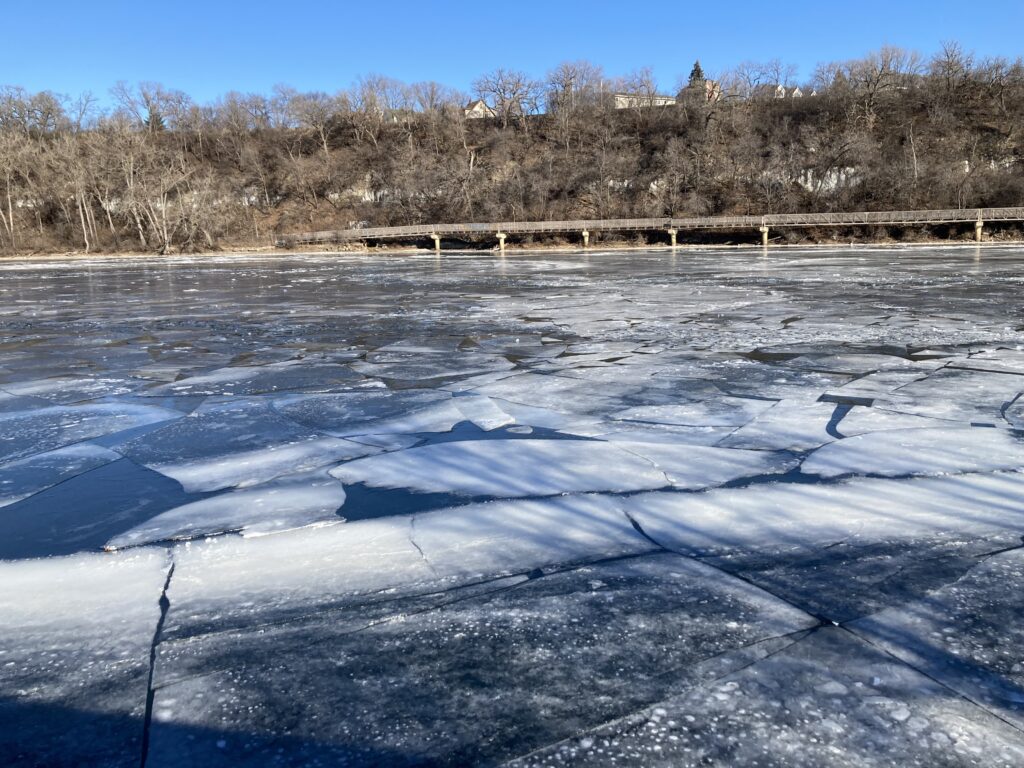4.1 miles
river road north/south
38 degrees / humidity: 84%
Colder today. Back to winter layers: long-sleeved green shirt, orange sweatshirt, black vest, black tights, gray buff, black gloves, purple/pink baseball cap, bright pink headband
A gray sky and a slight drizzle. Bright headlights through the trees where the road curves. Grit. Wet leaves on the trail. Pairs of fast runners approaching.
Listened to other runners’ voices, the sandy grit under my feet, car wheels as I ran north, put in my “Doin’ Time” playlist heading south, including Good Times by Chic. My favorite lines:
I want to live the sporty life
and
Clams on the half shell, and roller skates, roller skates — here’s the full verse:
A rumor has it that it’s getting late
Time marches on, just can’t wait
The clock keeps turning, why hesitate?
You silly fool; you can’t change your fate
Let’s cut the rug, a little jive and jitterbug
We want the best, we won’t settle for less
Don’t be a drag; participate
Clams on the half shell, and roller skates, roller skates
Good Times was released in June of 1979. The clam shells and roller skates line seems ridiculous (and it is, in a delightful way), but it also captures the vibe of 1979.
After seeing several orange things, I decided that would be my 10 things list. I could only remember 8.
8 Orange Things
- a giant orange water jug set up on a table for runners
- orange lichen (or moss?) on the north side of the ancient boulder
- orange bubble letter graffiti on the underside of the bridge
- my orange sweatshirt
- the flesh of a tree where a branch used to be, newly trimmed and exposed to the elements (water, air): rusty orange
- leaves on the ground: burnt orange
- an orange effort: a higher heart rate (see 25 may 2023)
- hot pink spray paint on the iron fence that I initially saw as orange
ceremony/ritual/circumambulation
A few things related to my planning of a loop run as ceremony:
first, something to chant, from James Schuyler’s Hymn to Life:
Press your face into the
Wet April chill: a life mask. Attune yourself to what is happening
Now, the little wet things
The whole thing, or maybe just the last bit, starting with “Attune yourself”? See also: 14 march 2024, 15 march 2024
Second, the bells! The bells of St. Thomas signaling the start of the ceremony, or the start of some part of the ceremony? Accompanied by:
Then Space – began to toll,
As all the Heavens are a Bell,
And Being, but an Ear,
And I, and silence, some strange Race,
Wrecked, solitary, here –
or
I was still ringing. I had been my whole life a bell, and never knew it until at that moment I was lifted and struck.
Pigrim at Tinker Creek/ Annie Dillard
converted into my 3/2 form:
My whole life
I’d been
a bell but
never
knew until
I was
lifted and
struck. Now
I am still
ringing.
Third, form inspirations? A psalm, like Julia B. Levine’s Ordinary Psalms?
Megan Feifer: Both of your poems share the words “Ordinary Psalm.” Why did you choose to name these poems as such? Does a psalm lose its reverence when it becomes ordinary? Is that the point?
Julia B. Levine: I am currently at work on a (hopefully) book-length collection of Ordinary Psalms. In these poems I am interested in the idea that the ordinary, if deeply lived and carefully attended to, are valid entryways into sacred or reverent experience. As a child I attended a Reform Jewish synagogue and always disliked the prayer books, though I loved the Torah. The difference, it seemed, had to do with the formal and vague language of prayer as contrasted with the heroic, vivid, and oftentimes earthy details of the weekly Torah readings. On reflection, this tonal difference in language may be the primary reason I don’t feel any sense of reverence toward an Old Testament God, but I do believe in the transcendent power of myth and stories. So, in contrast to psalms that rely on a formal address to an anthropomorphic God, I wanted to create a kind of personal prayer book that uses the living language of everyday details and experience to name and praise those aspects of this world that, for me, embody divinity.
Writer’s Insight: Julia B. Levine
JJJJJerome Ellis’ litany of names? Mary Oliver’s prayer as the attention before the words? lucille clifton’s praise of impossible things:
All Praises/ lucille clifton
Praise impossible things
Praise to hot ice
Praise flying fish
Whole numbers
Praise impossible things.
Praise all creation
Praise the presence among us
of the unfenced is.
Oh, that unfenced is! That line gets me every time.
